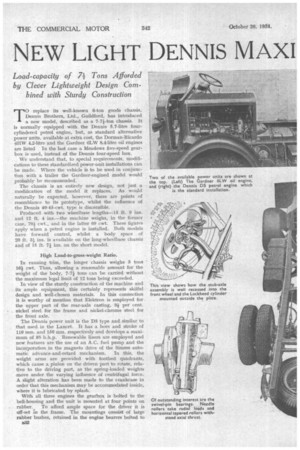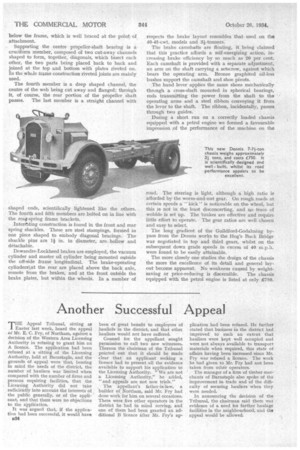NEW LIGHT DENNIS MAXI UM-LOAD FOUR-WHEELER
Page 46

Page 47

Page 48

If you've noticed an error in this article please click here to report it so we can fix it.
TO replace its well-known 6-ton goods chassis, Dennis Brothers, Ltd., Guildford, has introduced a new model, described as a 7-7+-ton chassis. I.t is normally equipped with. the Dennis 5.7-litre fourcylindered petrol engine, but, as standard alternative power units, available at extra cost, the Dorman-Ricardo 4HW 4.2-litre and the Gardner 6LW 8.4-litre oil engines are listed In the last case a Meadows five-speed gearbox is used, instead of the Dennis four-speed box. We understand that, to special requirements, modifications to these standardized power-unit installations can be made. Where the vehicle is to be used in conjunction with a trailer the Gardner-engined model would
probably be recommended. _ The chassis is an entirely new design, not just a modification of the model it replaces. As would naturally be expected, however, there are points of resemblance to its prototype, whilst the influence of the Dennis 40-45-cwt. type is discernible.
Produced with two wheelbase lengths-15 ft. 9 ins. and 12 ft. 4 ins.----the machine weighs, in the former case, 701 cwt., and in the latter. 69 cwt. These figures apply when a petrol engine is installed. Both models have forward control, whilst a body space of 20 ft. 3+ ins. is available on the long-wheelbase chassis and of 15 ft. 71 ins. on the short model.
High Load-to-gross-weight Ratio.
In running trim, the longer chassis weighs 3 tons 16+ cwt. Thus, allowing a reasonable amount for the weight of the body, 7-7f tons can be carried without the maximum legal limit of 12 tons being exceeded. In view of the sturdy construction of the machine and its ample equipment, this certainly represents skilful design and well-chosen materials. In this connection it is worthy of mention that Elektron is employed for the upper part of the rear-axle casting, 3+ per cent. nickel steel for the frame and nickel-chrome steel for the front axle. The Dennis power unit is the D3 type and similar to that used. in the Lancet. It has a bore and stroke of 110 mm. and 150 ram. respectively and develops a maxi. mum of 85 b.h.p. Renewable liners are employed and new features are the use of an A.C. fuel pump and the incorporation in the magneto drive of the Simms auto
matic advance-and-retard mechanism. In this, the weight arms are provided with toothed quadrants, which cause a pinion on the driven part to rotate, relative to the driving part, as the spring-loaded weights move under the varying influence of centrifugal force. A slight alteration has been made to the crankcase in order that this mechanism may be accommodated inside, where it is lubricated by splash.
With all three engines the gearbox is bolted to the bell-housing and the unit is mounted at four points on rubber., To afford ample space for the driver it is off-set in the frame. The mountings consist of large rubber bushes, retained in the engine bearers bolted to
B32 the frame and supporting within them the engine feet bolted to the crankcase.
Also attached direct to this part of the engine is the gear-lever box, to the bottom of which the clutch-pedal bracket is bolted, whilst the brake pedal is carried on the main-frame member.
A refinement found on the Gardner-engined model, in which the Meadows five-speed box is used, is a coupling rod between the gear lever and selector shaft, which incorporates two Spicer universal joints. On the petrol-engined chassis, where the distance is less, a short one-piece shaft is employed.
Power is transmitted from the gearbox by a two-piece propeller shaft, having three Spicer needle-roller univer
sal joints. This is supported in a rubber-mounted double-row ball bearing, and a torsional vibration damper is provided on the front part of the propeller shaft near the centre bearing.
The rear axle, of the overhead-worm type, affords a ratio of 8.25 to 1. The main part is a pot-type steel casting, the upper portion being of Elektron, as previously mentioned.
Minimized Steering-gear Friction.
Of special interest, the steering gear next deserves mention, the steering head being quite new. The swivel pins support radial loads by two needle-roller bearings, one at the top and one at the bottom, whilst axial thrust is taken by a bearing of the horizontal-tapered-roller type. The pins are accommodated well within the front wheels, but their axes do not actually coincide with the vertical diameters.
The steering box is an aluminium casting, and its mechanism is a steel worm with a white-metal-lined bronze nut, having one trunnion acting direct on to the drop-arm lever. For easy maintenance a single nipple supplies grease through three pipes to the two ends of the swivel pin and to the tie-rod ball joint.
With regard to the frame, the main members are of lighter gauge than formerly, being only / in. thick. The width of the flanges is 41 ins, and the maximum depth is 10 ins.. The members are straight, tapering downwards quickly at the front, but finishing with short lengths of parallel section. This simplifies the accommodation of engines of different dimensions. At the rear the members taper slowly upwards.
Some clever weight-saving has been effected in ' designing the cross-members. That at the extreme front is detachable and serves as a bumper. It is curved and of channel section, having the webs well cut away, except at the ends, in front of the longitudinals and at the centre. Being ahead of the radiator and wings, it affords protection to these parts and, in addition, carries the starting handle.
Behind the engine and passing below the gearbox the second cross-member is a dropped channel with its ends bolted inside the main channels. In the case of the Gardner-engined model, however, this member is bolted below the frame, which is well braced at the point of attachment.
Supporting the centre propeller-shaft bearing is a cruciform member, composed of two cut-away channels shaped to form, together, diagonals, which bisect each other, the two parts being placed back to back and joined at the top and bottom with plates riveted on. In the whole frame construction riveted joints are mainly used.
The fourth member is a deep shaped channel, the centre of the web being cut away and flanged; through it, of course, the rear portion of the propeller shaft passes. The last member is a straight channel with shaped ends, scientifically lightened like the others. The fourth and fifth members are bolted on in line with the rear-spring frame brackets.
Interesting construction is found in the front and rear spring shackles. These are steel stampings, formed in one piece shaped to embody diagonal bracings. The shackle pins are 1i in. in diameter, are hollow and detachable.
Dewandre-Lockheed brakes are employed, the vacuum cylinder and master off cylinder being mounted outside the off-side frame longitudinal. The brake-operating cylindersiiat the rear are placed above the back axle, remote from the brakes, and at the front outside the brake plates, but within the wheels. In a number of respects the brake layout resembles that used on the 40-45-cwt. models and 31-tonners.
The brake camshafts are floating, it being claimed that this practice affords a self-energizing action, increasing brake efficiency by so much as 20 per cent. Each camshaft is provided with a separate adjustment, an arm on the shaft carrying a setscrew, against which bears the operating arm. Bronze graphited oil-less bushes support the camshaft and shoe pivots.
The hand lever applies the same shoes mechanically through a cross-shaft mounted in spherical bearings, rods transmitting the power from the shaft to the operating arms and a steel ribbon conveying it from the lever to the shaft. The ribbon, incidentally, passes through two guides.
During a short ran on a correctly loaded chassis equipped with a petrol engine we formed a favourable impression of the performance of the machine on the
road. The steering is light, although a high ratio is afforded by the worm-and-nut gear. On rough roads at certain speeds a " kick" is noticeable on the wheel, but this is not in the least disconcerting, and no trace of wobble is set up. The brakes are effective and require little effort to operate. The gear ratios are well chosen and easy to select.
The long gradient of the Guildford-Godalming bypass from the Dennis works to the Hog's Back Bridge was negotiated in top and third gears, whilst on the subsequent down grade speeds in excess of 40 m.p.h. were found to be easily attainable.
The more closely one studies the design of the chassis the more the excellence of its detail and general layout become apparent. No weakness caused by weight saving or price-reducing is discernible. The chassis equipped with the petrol engine islisted at only £750.




























































































